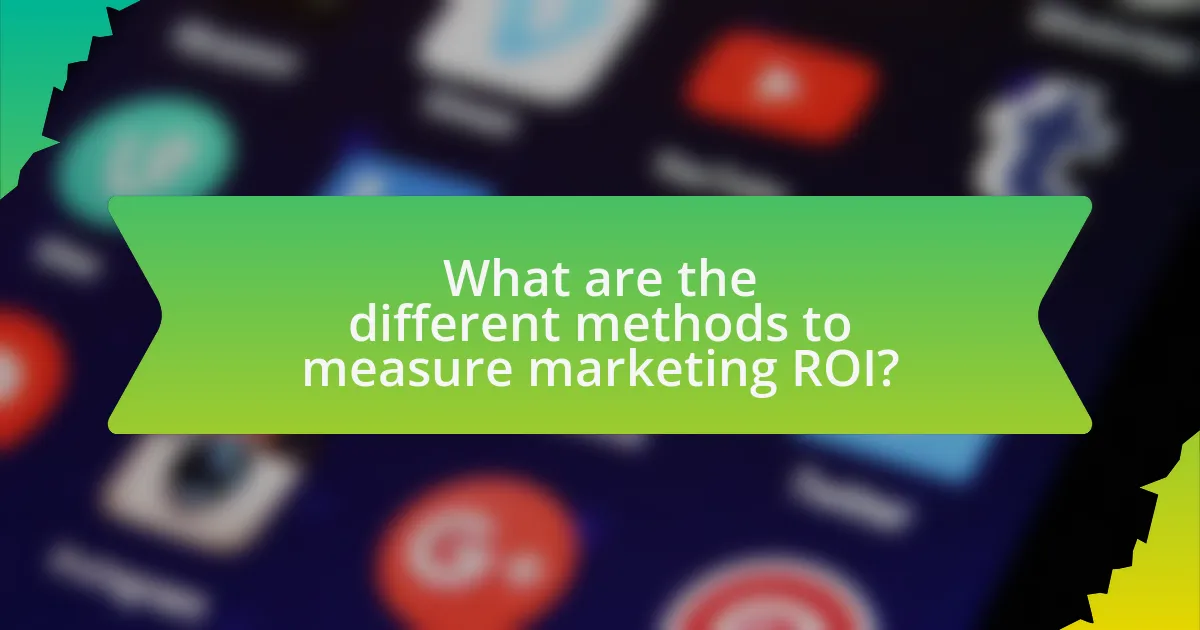The article focuses on measuring the Return on Investment (ROI) of marketing efforts, a critical metric for evaluating the efficiency and profitability of marketing expenditures. It outlines the calculation of ROI, emphasizing the importance of net profit, total investment cost, and the time period for accurate assessments. Various methods for measuring marketing ROI, including traditional and digital approaches, are discussed, along with the tools that assist in this process. Additionally, the article addresses challenges marketers face in data collection and attribution, the limitations of ROI as a performance metric, and best practices for effectively measuring ROI to enhance marketing strategies.

What is ROI in Marketing?
ROI in marketing, or Return on Investment, is a metric used to evaluate the efficiency and profitability of marketing expenditures. It is calculated by dividing the net profit generated from marketing activities by the total cost of those activities, often expressed as a percentage. For example, if a company spends $10,000 on a marketing campaign and generates $50,000 in revenue, the ROI would be calculated as ($50,000 – $10,000) / $10,000, resulting in an ROI of 400%. This metric helps businesses assess the effectiveness of their marketing strategies and make informed decisions about future investments.
How is ROI calculated in marketing efforts?
ROI in marketing efforts is calculated using the formula: (Net Profit / Cost of Investment) x 100. This formula quantifies the return generated from marketing activities relative to the costs incurred. For instance, if a marketing campaign costs $10,000 and generates $15,000 in revenue, the net profit is $5,000. Plugging these figures into the formula yields an ROI of 50%, indicating that for every dollar spent, there is a return of $1.50. This calculation is essential for assessing the effectiveness of marketing strategies and guiding future investment decisions.
What formulas are used to determine marketing ROI?
The primary formula used to determine marketing ROI is: (Net Profit from Marketing – Cost of Marketing) / Cost of Marketing. This formula calculates the return on investment by measuring the profit generated from marketing efforts relative to the costs incurred. For example, if a company spends $10,000 on a marketing campaign and generates $15,000 in profit, the ROI would be (15,000 – 10,000) / 10,000, resulting in an ROI of 0.5 or 50%. This calculation is essential for evaluating the effectiveness of marketing strategies and making informed budget decisions.
What variables are essential for calculating ROI?
The essential variables for calculating ROI include net profit, total investment cost, and time period. Net profit represents the revenue generated from marketing efforts minus the costs associated with those efforts. Total investment cost encompasses all expenses related to the marketing campaign, such as advertising spend, labor, and materials. The time period is crucial as it defines the duration over which the ROI is measured, allowing for a clear assessment of performance. These variables are foundational in determining the effectiveness of marketing strategies and ensuring accurate ROI calculations.
Why is measuring ROI important for marketers?
Measuring ROI is crucial for marketers because it quantifies the effectiveness of marketing campaigns in generating profit relative to their costs. This metric enables marketers to assess which strategies yield the highest returns, allowing for informed decision-making and resource allocation. For instance, a study by HubSpot found that companies that measure ROI are 1.6 times more likely to achieve their marketing goals, highlighting the importance of this practice in optimizing marketing performance.
How does ROI measurement influence marketing strategies?
ROI measurement directly influences marketing strategies by providing quantifiable insights into the effectiveness of marketing campaigns. By calculating ROI, marketers can identify which strategies yield the highest returns, allowing them to allocate resources more efficiently. For instance, a study by HubSpot found that companies that measure ROI are 1.6 times more likely to achieve their marketing goals. This data-driven approach enables marketers to optimize their campaigns, focus on high-performing channels, and ultimately improve overall marketing performance.
What insights can ROI provide about marketing effectiveness?
ROI provides critical insights into marketing effectiveness by quantifying the financial return generated from marketing investments. By calculating ROI, businesses can assess which marketing strategies yield the highest returns, enabling data-driven decisions. For instance, a study by HubSpot found that companies with a documented marketing strategy are 313% more likely to report success in their ROI. This metric allows marketers to identify successful campaigns, optimize resource allocation, and justify marketing budgets based on performance outcomes.

What are the different methods to measure marketing ROI?
The different methods to measure marketing ROI include the following: the Return on Investment formula, Customer Lifetime Value analysis, Marketing Attribution models, and the Cost per Acquisition metric. The Return on Investment formula calculates ROI by dividing net profit from marketing activities by the total marketing costs, providing a clear percentage that indicates profitability. Customer Lifetime Value analysis estimates the total revenue a customer generates during their relationship with a brand, helping to assess the long-term impact of marketing efforts. Marketing Attribution models, such as first-click or last-click attribution, assign value to different touchpoints in the customer journey, allowing marketers to understand which channels contribute most to conversions. Lastly, the Cost per Acquisition metric measures the total cost of acquiring a new customer, enabling businesses to evaluate the efficiency of their marketing spend. These methods are widely recognized in the marketing industry for their effectiveness in quantifying the financial impact of marketing strategies.
How do traditional methods compare to digital methods in measuring ROI?
Traditional methods of measuring ROI, such as surveys and sales data analysis, often lack the immediacy and granularity of digital methods, which utilize real-time analytics and tracking tools. Digital methods provide precise metrics, allowing marketers to assess campaign performance through key performance indicators like conversion rates and customer engagement metrics, while traditional methods may rely on broader, less timely data. For instance, a study by HubSpot found that 70% of marketers believe digital marketing is more effective for measuring ROI due to its ability to track user behavior and interactions in real-time, contrasting with traditional methods that may take weeks or months to yield results.
What are the key differences between traditional and digital ROI measurement?
Traditional ROI measurement primarily relies on historical data and broad metrics, while digital ROI measurement utilizes real-time analytics and specific performance indicators. Traditional methods often focus on overall sales and revenue generated from marketing campaigns, making it challenging to attribute success to specific efforts. In contrast, digital ROI allows for precise tracking of user engagement, conversion rates, and customer acquisition costs through tools like Google Analytics and social media insights. This capability enables marketers to adjust strategies quickly based on immediate feedback, enhancing overall effectiveness.
Which method is more effective for specific marketing channels?
The method that is more effective for specific marketing channels is the use of multi-touch attribution. Multi-touch attribution allows marketers to assign value to each touchpoint in the customer journey, providing a clearer picture of how different channels contribute to conversions. Research by the Marketing Accountability Standards Board indicates that companies using multi-touch attribution see an average ROI increase of 20% compared to those using single-touch models. This effectiveness stems from its ability to capture the complexity of consumer interactions across various platforms, leading to more informed marketing strategies.
What tools can assist in measuring marketing ROI?
Tools that can assist in measuring marketing ROI include Google Analytics, HubSpot, and Marketo. Google Analytics provides insights into website traffic and conversion rates, allowing marketers to track the effectiveness of campaigns. HubSpot offers comprehensive marketing analytics that measure lead generation and customer acquisition costs, while Marketo specializes in marketing automation and performance metrics. These tools enable businesses to quantify their marketing efforts and assess the financial return on investment, ensuring data-driven decision-making.
What are the most popular analytics tools for tracking ROI?
The most popular analytics tools for tracking ROI include Google Analytics, HubSpot, and Adobe Analytics. Google Analytics provides comprehensive tracking of website traffic and user behavior, allowing businesses to measure the effectiveness of their marketing campaigns. HubSpot offers integrated marketing, sales, and service tools that help track ROI across various channels, including email and social media. Adobe Analytics delivers advanced data analysis capabilities, enabling organizations to gain insights into customer interactions and optimize their marketing strategies. These tools are widely recognized for their effectiveness in measuring and analyzing return on investment in marketing efforts.
How can CRM systems enhance ROI measurement?
CRM systems enhance ROI measurement by providing detailed analytics on customer interactions and sales performance. These systems track customer data, enabling businesses to analyze the effectiveness of marketing campaigns and sales strategies. For instance, a study by Nucleus Research found that CRM applications can increase sales productivity by up to 34%, directly impacting ROI. By consolidating customer information and automating reporting, CRM systems allow for precise measurement of marketing efforts, helping organizations identify which strategies yield the highest returns.

What challenges do marketers face when measuring ROI?
Marketers face several challenges when measuring ROI, primarily due to difficulties in data collection and attribution. Accurate data collection is often hindered by fragmented data sources, making it hard to consolidate information from various channels. Additionally, attribution challenges arise from the complexity of multi-channel marketing, where determining which touchpoints contribute to conversions can be ambiguous. According to a survey by HubSpot, 44% of marketers struggle to measure the ROI of their marketing efforts, highlighting the prevalence of these issues.
How can data accuracy impact ROI calculations?
Data accuracy significantly impacts ROI calculations by ensuring that the financial metrics used to assess marketing effectiveness are reliable. When data is accurate, it reflects true customer behavior, sales figures, and marketing costs, leading to precise ROI assessments. For instance, a study by the Data Warehousing Institute found that organizations with high data quality can achieve ROI improvements of up to 30%. Inaccurate data, on the other hand, can lead to misguided strategies, misallocation of resources, and ultimately, a distorted view of marketing performance. Therefore, maintaining high data accuracy is essential for making informed decisions that enhance ROI.
What common data collection issues affect ROI measurement?
Common data collection issues that affect ROI measurement include data accuracy, data completeness, and data consistency. Data accuracy is crucial because inaccurate data can lead to misleading ROI calculations; for instance, a study by the Data Warehousing Institute found that organizations lose 20-25% of their revenue due to poor data quality. Data completeness is also vital, as missing data can skew results; according to a report by IBM, 70% of organizations cite incomplete data as a significant barrier to effective analytics. Lastly, data consistency across different sources is essential; inconsistent data can create confusion and misinterpretation, which can ultimately distort ROI assessments.
How can marketers ensure data integrity for accurate ROI?
Marketers can ensure data integrity for accurate ROI by implementing robust data management practices, including regular data audits, validation processes, and the use of reliable data sources. Regular audits help identify discrepancies and errors in data, while validation processes ensure that the data collected is accurate and relevant. For instance, a study by the Data Warehousing Institute found that organizations that conduct regular data quality assessments can improve their decision-making processes by up to 30%. Additionally, utilizing reputable data sources minimizes the risk of inaccuracies, thereby enhancing the reliability of ROI calculations.
What are the limitations of ROI as a performance metric?
ROI has several limitations as a performance metric, primarily its inability to capture the full impact of marketing efforts. First, ROI focuses solely on financial returns, neglecting qualitative benefits such as brand awareness and customer loyalty, which are crucial for long-term success. Additionally, ROI calculations often rely on short-term data, failing to account for delayed effects of marketing campaigns that may yield returns over an extended period. Furthermore, ROI does not consider external factors like market conditions or competitive actions that can influence performance outcomes. Lastly, the metric can be easily manipulated by altering the inputs, such as costs or revenue, leading to misleading interpretations of marketing effectiveness.
How does ROI fail to capture the full value of marketing efforts?
ROI fails to capture the full value of marketing efforts because it primarily focuses on short-term financial returns, neglecting long-term brand equity, customer loyalty, and intangible benefits. While ROI quantifies immediate revenue generated from marketing campaigns, it does not account for factors such as customer lifetime value, brand awareness, and market positioning, which are crucial for sustained business growth. Research indicates that companies with strong brand equity can achieve up to 20% higher sales growth compared to competitors, demonstrating that ROI alone does not reflect the comprehensive impact of marketing initiatives.
What alternative metrics can complement ROI measurements?
Alternative metrics that can complement ROI measurements include Customer Lifetime Value (CLV), Customer Acquisition Cost (CAC), and Net Promoter Score (NPS). CLV quantifies the total revenue a business can expect from a single customer account, providing insight into long-term profitability beyond immediate returns. CAC measures the cost associated with acquiring a new customer, allowing businesses to assess the efficiency of their marketing strategies. NPS gauges customer satisfaction and loyalty, offering qualitative insights that can inform marketing effectiveness. These metrics collectively provide a more comprehensive view of marketing performance, enhancing the understanding of ROI by incorporating both financial and customer-centric perspectives.
What best practices should marketers follow to effectively measure ROI?
Marketers should follow several best practices to effectively measure ROI, including setting clear objectives, utilizing appropriate metrics, and leveraging data analytics tools. Clear objectives provide a benchmark for success, while metrics such as customer acquisition cost and lifetime value help quantify performance. Data analytics tools, like Google Analytics, enable marketers to track campaign performance in real-time, facilitating informed decision-making. According to a study by HubSpot, companies that prioritize data-driven marketing are 6 times more likely to be profitable year-over-year, underscoring the importance of these practices in measuring ROI accurately.


